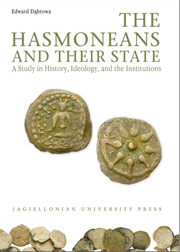Book contents
- Frontmatter
- Contents
- Introduction
- Abbreviations
- Part I Judea under the Hasmoneans (167–63 BCE)
- Part II The Institutions of the Hasmonean State
- Part III Society
- Conclusions
- Bibliography
- Index of Personal Names
- Index of Place Names
- Index of Ancient Sources
- Electrum - Volumes Published
- The Hasmonean State
Introduction
Published online by Cambridge University Press: 05 September 2014
- Frontmatter
- Contents
- Introduction
- Abbreviations
- Part I Judea under the Hasmoneans (167–63 BCE)
- Part II The Institutions of the Hasmonean State
- Part III Society
- Conclusions
- Bibliography
- Index of Personal Names
- Index of Place Names
- Index of Ancient Sources
- Electrum - Volumes Published
- The Hasmonean State
Summary
The restoration of Jewish statehood in the late 2nd century BCE was an event of great historical significance. The Jewish state had ceased to exist over 400 years previously due to expansion into Palestine by the Babylonian king Nebuchadnezzar II, who first subjugated the kingdom of Judah, the last remnant of David and Solomon's monarchy, and captured and destroyed Jerusalem (587/586). The credit for restoring Jewish statehood is due to the Hasmoneans, who led an armed revolt they had started against a Hellenistic religious reform in Judea during the reign of Antiochus IV Epiphanes. Not only did they win broad support for their actions among their people, but they also displayed great political skill in dealing with the Seleucids. They shrewdly took advantage of all favorable circumstances, domestic and international alike, first to carve out considerable autonomy within the Seleucid state, and then in the late 2nd century BCE, during John Hyrcanus' reign, to win full independence from Syrian kings.
The history of the Hasmoneans has long caused disputes among scholars, who are far from agreement about the chronology of events, their importance, and the identities of all their actors. There are no indications that such doubts will be resolved anytime soon. The aim of this study, therefore, is not to present a new reconstruction of Hasmonean history, but to describe the institutions of the state they created.
- Type
- Chapter
- Information
- The Hasmoneans and their StateA Study in History, Ideology, and the Institutions, pp. 7 - 8Publisher: Jagiellonian University PressPrint publication year: 2009



